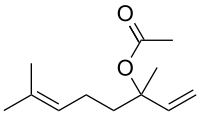Lavender oil

Lavender oil is an essential oil obtained by distillation from the flower spikes of certain species of lavender. Two forms are distinguished, lavender flower oil, a colorless oil, insoluble in water, having a density of 0.885 g/mL; and lavender spike oil, a distillate from the herb Lavandula latifolia, having density 0.905 g/mL. Like all essential oils, it is not a pure compound; it is a complex mixture of naturally occurring phytochemicals, including linalool and linalyl acetate. Kashmir Lavender oil is famous for being produced from lavender at the foothills of the Himalayas. As of 2011, the biggest lavender oil producer in the world is Bulgaria.[1]
Uses
Lavender oil has long been used in the production of perfume.[2]:184-186
It is used in aromatherapy but there is little evidence that it does anything.[3]
Oil of spike lavender was used as a solvent in oil painting, mainly before the use of distilled turpentine became common.[4]
Research
Small clinical studies of Silexan, an oral preparation of lavender oil, have been found it may be useful for alleviating low-level anxiety and sleep disorders.[3][5]
Lavender oil has been implicated in prepubertal gynecomastia, the abnormal development of breasts in pre-adolescent boys.[6]
Composition
The primary components of lavender oil are linalool (51%) and linalyl acetate (35%).[7] Other components include α-pinene, limonene, 1,8-cineole, cis- and trans-ocimene, 3-octanone, camphor, caryophyllene, terpinen-4-ol and lavendulyl acetate. The composition of lavender essential oil as obtained by chromatography:
| Family | Composition | Lavande officinale Lavandula angustifolia |
Lavande aspic Lavandula latifolia |
|---|---|---|---|
| Terpenes / Monoterpenols |
 Linalool | 28.92 % | 49.47 % |
| α-Terpineol | 0.90% | 1.08% | |
| γ-Terpineol | 0.09% | ||
| Borneol | 1.43% | ||
| Isoborneol | 0.82% | ||
| Terpinen-4-ol | 4.32% | ||
| Nerol | 0.20% | ||
| Lavandulol | 0.78% | ||
| Terpenes / Terpene esters |
 | 32.98 % | |
| Geranyl acetate | 0.60% | ||
| Neryl acetate | 0.32% | ||
| Octene-3-yl acetate | 0.65% | ||
| Lavandulyl acetate | 4.52% | ||
| Terpenes / Monoterpenes |
Myrcene | 0.46% | 0.41% |
| α-Pinene | 0.54% | ||
| β-Pinene | 0.33% | ||
| Camphene | 0.30% | ||
| (E)-β-Ocimene | 3.09% | ||
| (Z)-β-Ocimene | 4.44% | ||
| β-Phellandrene | 0.12% | ||
| Terpenes / Terpenoid oxides |
 Eucalyptol (1,8-cineol) | 25.91 % | |
| Terpenes / Sesquiterpenes |
β-Caryophyllene | 4.62% | 2.10% |
| β-Farnesene | 2.73% | ||
| Germacrene | 0.27% | ||
| α-Humulene | 0.28% | ||
| Ketones |  Camphor |
0.85% | 13.00 % |
| 3-Octanone | 0.72% | ||
| Cryptone | 0.35% |
References
- ↑ Bulgarian lavender producers worried about demand drop, China Post, 14 July 2011
- ↑ N. Groom. New Perfume Handbook. Springer Science & Business Media, 1997 ISBN 9780751404036
- ↑ 3.0 3.1 National Center for Complementary and Alternative Medicine. Last updated March 2008. Herbs at a Glance: Lavender
- ↑ "Solvent", pp 605-606 in The Grove Encyclopedia of Materials and Techniques in Art, edited by Gerald W. R. Ward. Oxford University Press, 2008 ISBN 9780195313918
- ↑ Kasper S (2013). "An orally administered lavandula oil preparation (Silexan) for anxiety disorder and related conditions: an evidence based review". Int J Psychiatry Clin Pract (Review). 17 Suppl 1: 15–22. doi:10.3109/13651501.2013.813555. PMID 23808618.
- ↑ Henley DV, Korach KS (July 2010). "Physiological effects and mechanisms of action of endocrine disrupting chemicals that alter estrogen signaling". Hormones 9 (3): 191–205. doi:10.14310/horm.2002.1270. PMID 20688617.
- ↑ A. Prashar, I. C. Locke, C. S. Evans (2004). Cytotoxicity of lavender oil and its major components to human skin cells. Cell Proliferation 37 (3), 221–229.
See also
- Lavender
- Essential oil